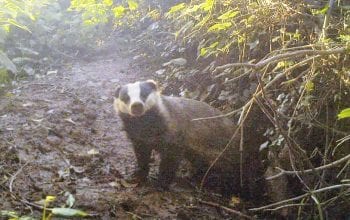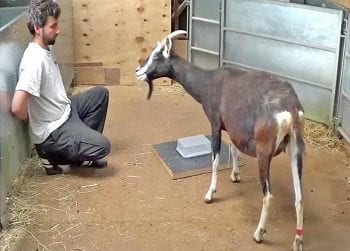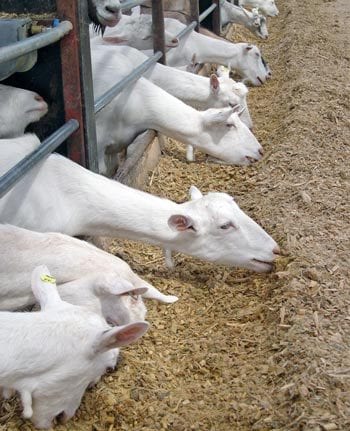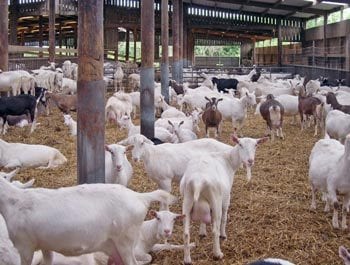12 Nov 2018
Event delivers hot topics – from antimicrobial use to farm survey
David Harwood recounts a full programme at the Goat Veterinary Society spring meeting from various specialists in animal health.

Figure 1. A confirmed TB lesion. Note the liquid nature of the pus compared to the more typical caseous lesion.
The spring meeting of the Goat Veterinary Society (GVS) was held at Leicester Racecourse, and attended by a good mix of both veterinary surgeons, goat owners and stock keepers. Meetings secretary Kathy Anzuino had again developed a very varied programme.
Antimicrobial use
The first talk of the day – “The UK approach to antimicrobial resistance” – was given by Andrea Turner of Langford Vets. She began by updating the audience on current activities aimed at reducing antimicrobial use in the livestock sector – making specific reference to the Lord Jim O’Neill’s report of 2016. In this report, it was stated “50mg/kg would be a reasonable objective for many high-income countries, but each country will need to have, and regularly review, its own ambitious targets”.
The major concern is over the use of what are described as critically important antibiotics (CIAs) – this is an antimicrobial class used to treat infections in humans caused by either bacteria that may be transmitted to humans from non-human sources, or bacteria that may acquire resistance genes from non-human sources. The CIAs licensed for use in food-producing animals in the UK are cephalosporins, fluoroquinolones, macrolides, aminoglycosides and (somewhat surprisingly) penicillins – although the first three groups listed are given highest priority.
Several initiatives have been aimed at achieving the O’Neill targets; some are sector-led, others led by farm assurance schemes and/or major supermarkets. The two major wholesale goat milk producers in the UK each make reference to antimicrobial usage on their websites. Most goats treated with antibiotics will receive an antibiotic under VMD cascade principles as, with one exception, none have a marketing authorisation for use in goats. As such, target reduction has been problematic, although the GVS has produced a statement on antimicrobial resistance in the species.
Tuberculosis
British goats overview
An “Overview of TB in goats in GB and risks to public health” was the first of two papers on TB given by Laura Wilson – a senior veterinary inspector with the APHA. Although the majority of goat milk sold in the UK is pasteurised, a demand for raw milk exists – sold either at the farm gate or via farmer markets – and often due to lifestyle choices and a feeling the raw product is healthier. Interestingly, research has suggested it is the younger generation that consumes proportionately more raw milk.
Clinical signs of TB in goats can often be vague, with signs related to the organ system affected (Figure 1). Chronic loss of condition, reduced appetite, reduced milk yield and a chronic cough have all been described. The number of goat cases of TB in the UK remain at a relatively low level, and recent peaks have been exaggerated by some large herd outbreaks.

The control measures for TB in goats do not include routine testing and are based on mandatory reporting of any suspicion of disease to the APHA. Movement restrictions will be put in place while an investigation is undertaken, which includes skin and blood testing, removal of reactors and clinical cases with compensation. Targeted testing is also carried out of goat herds co-located with, or contiguous to, confirmed disease in cattle herds. To protect those consuming raw milk, compliance with on-farm hygiene principles is vital, with relevant health warnings on labelling.
Badgers, bovine and caprine
The second paper, “Badgers and bovine/caprine TB”, was presented by Andy Robertson, an ecologist from the University of Exeter. He described the badger as being a nocturnal mustelid that lives in non-cooperative social groups varying in size from 2 to 20, with an average size of 8 (Figure 2). The earthworm is its key source of food, although it is also an adaptable omnivore and will readily consume invertebrates, such as slugs and snails, fruits and berries, wheat or maize crops, small vertebrates and, significantly, animal feed, if it can gain access.
The number of social groups has doubled between two surveys undertaken from 1985 to 1988 and 2011 to 2013. TB in badgers can result primarily in pulmonary infection, with excretion in sputum, urine, faeces and pus from superficial bite wounds or discharging abscesses. Infected badgers do not necessarily exhibit signs of illness, and some can live with the infection and multiply successfully.
Badgers are a “good” reservoir of TB because they are relatively long-lived; even if infected, their social structure means high densities of infection can develop, and a relatively large overlap exists with cattle populations. It is not only badgers that can become infected with bTB, it has also been confirmed in deer and other wild mammals.

The TB organism can survive in soil for 11 to 88 days, in cattle faeces for 2 to 6 months, and is also relatively stable in other environmental sources. Direct “nose to nose” contact rarely occurs; most transfer is indirect via badger latrines and faeces, urine or sputum contaminating feed and water troughs, feed stores, mineral licks, and so on.
An APHA study in a known TB area showed badger activity was identified in 41% of farm yards and cattle housing studied, with visits increasing in dry weather, when other food sources may be less available. The speaker suggested having gates and fences higher than 120cm, with a gap beneath the gate of less than 7.5cm. With reference to the badger cull and its potential benefit, the speaker stated results had been mixed to date and it was too early to make firm conclusions.
Goat behaviour
Alan McGellicott, of the University of Roehampton, then gave a very thought-provoking talk on goat behaviour – “The goat as a model for positive welfare research” – illustrated throughout by video footage of experimental observations. The speaker had been studying behavioural activities in a range of animals and birds, looking particularly at vocal communication, problem solving and memory, emotions, human-directed behaviours and perception of human facial expressions linked to emotions.
One study showed female goats did not forge their kids’ calls, even when separated for long periods. They know what their friends sound like when calling each other. They are very skilled at learning two-step tasks to retrieve a food treat from a sealed container, (although the occasional goat resorted to breaking in with its horns), and this skill can be remembered and quickly used at least one year after it was learned.
In a further trial, after training, goats were encouraged to move towards images of human faces that displayed either happiness or anger and annoyance, and interacted in preference and for longer with happy faces, suggesting they could distinguish between emotional valences. Figure 3 shows a goat called Willow exhibiting audience-dependent human-directed gazing behaviour towards Christian Nawroth, in a problem-solving task in which a feed treat is sealed in a container that Willow could previously open unaided (Nawroth et al, 2016).
Poisoned feed

Jo Payne, toxicology advisor to the APHA, next presented a field approach to suspected poisoning cases in goats – “Is it feed-related poisoning?” – which could include a range of both chemical and plant agents. She reminded the audience of the Food Safety Act 1990, which enshrined a “due diligence” to protect the food chain. Four scenarios were described in which a potential poisoning incident may be suspected:
- A disease outbreak where evidence exists that a toxic substance may have been ingested.
- Disease associated with feed or a defined environment (Figure 4).
- A very sudden disease onset – often with significant numbers affected.
- Any disease or production problem for which no alternative diagnosis exists.
Any suspicion must be accompanied by a detailed investigation, including ruling out potential differential diagnoses, collecting suitable samples in consultation with, for example, APHA/Scotland’s Rural College veterinary staff who decide, based on the available information, what action needs to be taken, and whether a risk to the food chain exists – and involvement of the Food Standards Agency. More serious risks would involve milking dairy goats or meat goats close to slaughter.
Hydrometra
Emily Gascoigne, of Synergy Farm Vets, gave a definition of “Hydrometra (cloudburst) in the milking goat” as an “anoestrus condition that occurs when the corpus luteum persists in the absence of a viable conceptus and aseptic fluid accumulates.” This fluid is not homologous with either allantoic or amniotic fluid. Herd prevalence may range from 3% to 20.8% in affected herds.
The condition can have a profound effect on productivity, reducing the number of lactating females, and reducing milk yields in those affected in addition to increased input costs through routine scanning and treatment. It is seen more commonly in milking herds (Figure 5), as opposed to meat or fibre goats, and is rare in young goats. There appears to be a higher percentage where hormonal induction of reproduction or out-of-season natural service has been practised.
Farm study
The final paper of the afternoon – “Dairy goat farm survey” – was presented by Kathy Anzuino, who is undertaking her PhD studies on the UK dairy goat sector. She had begun by surveying 70 members of the recently formed Milking Goat Association, requesting information about farm background, key husbandry practices, and farmer observations and main concerns.
The survey covered 46 farms with a total of 24,372 milking goats (approximately 37% of commercial farms and 54% of total dairy goats in England and Wales). Reported milk yields varied from 700L to 1,800L, with a median of 1,022L. The majority were housed all year, with only eight farms (17%) grazing outdoors. The study compared and contrasted feeding systems, kid management, milking routines, milking frequency, foot trimming, male kid options, and infectious disease prevalence and control methods.
Clinical discussion
In the final session before the meeting closed, members shared problem cases with the audience, facilitated by GVS secretary Ben Dustan.
The society’s next meeting was due to be held at Chepstow Racecourse on 8 November. For information, visit www.goatvetsoc.co.uk
- Note some drugs in this article are used under the cascade.
Latest news


